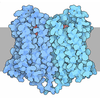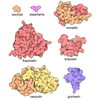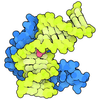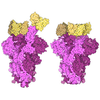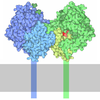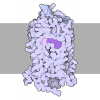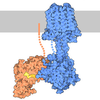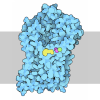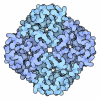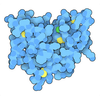[English] 日本語
 Yorodumi
Yorodumi- PDB-8zw0: Cryo-EM strcuture of Prostaglandin D2 Receptor DP1 activated by PGD2 -
+ Open data
Open data
- Basic information
Basic information
| Entry | Database: PDB / ID: 8zw0 | |||||||||||||||||||||
|---|---|---|---|---|---|---|---|---|---|---|---|---|---|---|---|---|---|---|---|---|---|---|
| Title | Cryo-EM strcuture of Prostaglandin D2 Receptor DP1 activated by PGD2 | |||||||||||||||||||||
 Components Components |
| |||||||||||||||||||||
 Keywords Keywords | MEMBRANE PROTEIN / Prostaglandin / DP1 / PGD2 | |||||||||||||||||||||
| Function / homology |  Function and homology information Function and homology informationprostaglandin J receptor activity / prostaglandin D receptor activity / Prostanoid ligand receptors / adenosine metabolic process / cellular response to prostaglandin D stimulus / male sex determination / sleep / mast cell degranulation / PKA activation in glucagon signalling / hair follicle placode formation ...prostaglandin J receptor activity / prostaglandin D receptor activity / Prostanoid ligand receptors / adenosine metabolic process / cellular response to prostaglandin D stimulus / male sex determination / sleep / mast cell degranulation / PKA activation in glucagon signalling / hair follicle placode formation / developmental growth / D1 dopamine receptor binding / intracellular transport / vascular endothelial cell response to laminar fluid shear stress / renal water homeostasis / Hedgehog 'off' state / adenylate cyclase-activating adrenergic receptor signaling pathway / activation of adenylate cyclase activity / regulation of insulin secretion / cellular response to glucagon stimulus / adenylate cyclase activator activity / trans-Golgi network membrane / negative regulation of inflammatory response to antigenic stimulus / electron transport chain / bone development / G-protein beta/gamma-subunit complex binding / platelet aggregation / cognition / Olfactory Signaling Pathway / Activation of the phototransduction cascade / G beta:gamma signalling through PLC beta / Presynaptic function of Kainate receptors / Thromboxane signalling through TP receptor / G protein-coupled acetylcholine receptor signaling pathway / adenylate cyclase-activating G protein-coupled receptor signaling pathway / G-protein activation / Activation of G protein gated Potassium channels / Inhibition of voltage gated Ca2+ channels via Gbeta/gamma subunits / Prostacyclin signalling through prostacyclin receptor / G beta:gamma signalling through CDC42 / Glucagon signaling in metabolic regulation / G beta:gamma signalling through BTK / Synthesis, secretion, and inactivation of Glucagon-like Peptide-1 (GLP-1) / ADP signalling through P2Y purinoceptor 12 / Sensory perception of sweet, bitter, and umami (glutamate) taste / photoreceptor disc membrane / Glucagon-type ligand receptors / Adrenaline,noradrenaline inhibits insulin secretion / Vasopressin regulates renal water homeostasis via Aquaporins / G alpha (z) signalling events / Glucagon-like Peptide-1 (GLP1) regulates insulin secretion / cellular response to catecholamine stimulus / ADORA2B mediated anti-inflammatory cytokines production / ADP signalling through P2Y purinoceptor 1 / G beta:gamma signalling through PI3Kgamma / Cooperation of PDCL (PhLP1) and TRiC/CCT in G-protein beta folding / sensory perception of smell / adenylate cyclase-activating dopamine receptor signaling pathway / GPER1 signaling / Inactivation, recovery and regulation of the phototransduction cascade / cellular response to prostaglandin E stimulus / G-protein beta-subunit binding / heterotrimeric G-protein complex / G alpha (12/13) signalling events / sensory perception of taste / extracellular vesicle / signaling receptor complex adaptor activity / Thrombin signalling through proteinase activated receptors (PARs) / positive regulation of cold-induced thermogenesis / G protein activity / positive regulation of cytosolic calcium ion concentration / GTPase binding / retina development in camera-type eye / Ca2+ pathway / High laminar flow shear stress activates signaling by PIEZO1 and PECAM1:CDH5:KDR in endothelial cells / fibroblast proliferation / G alpha (i) signalling events / Hydrolases; Acting on acid anhydrides; Acting on GTP to facilitate cellular and subcellular movement / G alpha (s) signalling events / phospholipase C-activating G protein-coupled receptor signaling pathway / G alpha (q) signalling events / Ras protein signal transduction / periplasmic space / electron transfer activity / Extra-nuclear estrogen signaling / cell population proliferation / G protein-coupled receptor signaling pathway / inflammatory response / iron ion binding / lysosomal membrane / GTPase activity / synapse / heme binding / protein-containing complex binding / GTP binding / signal transduction / extracellular exosome / metal ion binding / membrane / plasma membrane Similarity search - Function | |||||||||||||||||||||
| Biological species |  Homo sapiens (human) Homo sapiens (human)  | |||||||||||||||||||||
| Method | ELECTRON MICROSCOPY / single particle reconstruction / cryo EM / Resolution: 2.72 Å | |||||||||||||||||||||
 Authors Authors | Xu, J. / Xu, Y. / Wu, C. / Xu, H.E. | |||||||||||||||||||||
| Funding support |  China, 1items China, 1items
| |||||||||||||||||||||
 Citation Citation |  Journal: Proc Natl Acad Sci U S A / Year: 2025 Journal: Proc Natl Acad Sci U S A / Year: 2025Title: Molecular basis for ligand recognition and receptor activation of the prostaglandin D2 receptor DP1. Authors: Jiuyin Xu / Yanli Wu / Youwei Xu / Yang Li / Xinheng He / Heng Zhang / James Jiqi Wang / Jingjing Hou / Junrui Li / Wen Hu / Kai Wu / Qingning Yuan / Canrong Wu / H Eric Xu /  Abstract: The prostaglandin D2 receptor 1 (DP1), a rhodopsin-like Class A GPCR, orchestrates critical physiological and pathological processes, ranging from sleep regulation to inflammatory responses and ...The prostaglandin D2 receptor 1 (DP1), a rhodopsin-like Class A GPCR, orchestrates critical physiological and pathological processes, ranging from sleep regulation to inflammatory responses and cardiovascular function. Despite its therapeutic significance, structural insights into DP1 activation mechanisms have remained elusive. Here, using cryoelectron microscopy (cryo-EM), we determined high-resolution structures of human DP1 in both inactive and active states, with the latter captured in complex with its endogenous agonist PGD2 or the synthetic agonist BW245C, bound to the stimulatory G protein, Gs. Our structures, coupled with functional and mutagenesis studies, unveiled unique structural features of DP1, including an alternative activation mechanism, ligand-selectivity determinants, and G protein coupling characteristics. These molecular insights provide a rational framework for designing selective DP1-targeted therapeutics, both agonists and antagonists, with enhanced specificity and reduced off-target effects, opening broad avenues for treating DP1-associated disorders. | |||||||||||||||||||||
| History |
|
- Structure visualization
Structure visualization
| Structure viewer | Molecule:  Molmil Molmil Jmol/JSmol Jmol/JSmol |
|---|
- Downloads & links
Downloads & links
- Download
Download
| PDBx/mmCIF format |  8zw0.cif.gz 8zw0.cif.gz | 207.6 KB | Display |  PDBx/mmCIF format PDBx/mmCIF format |
|---|---|---|---|---|
| PDB format |  pdb8zw0.ent.gz pdb8zw0.ent.gz | 157.6 KB | Display |  PDB format PDB format |
| PDBx/mmJSON format |  8zw0.json.gz 8zw0.json.gz | Tree view |  PDBx/mmJSON format PDBx/mmJSON format | |
| Others |  Other downloads Other downloads |
-Validation report
| Summary document |  8zw0_validation.pdf.gz 8zw0_validation.pdf.gz | 1.6 MB | Display |  wwPDB validaton report wwPDB validaton report |
|---|---|---|---|---|
| Full document |  8zw0_full_validation.pdf.gz 8zw0_full_validation.pdf.gz | 1.6 MB | Display | |
| Data in XML |  8zw0_validation.xml.gz 8zw0_validation.xml.gz | 43 KB | Display | |
| Data in CIF |  8zw0_validation.cif.gz 8zw0_validation.cif.gz | 62 KB | Display | |
| Arichive directory |  https://data.pdbj.org/pub/pdb/validation_reports/zw/8zw0 https://data.pdbj.org/pub/pdb/validation_reports/zw/8zw0 ftp://data.pdbj.org/pub/pdb/validation_reports/zw/8zw0 ftp://data.pdbj.org/pub/pdb/validation_reports/zw/8zw0 | HTTPS FTP |
-Related structure data
| Related structure data |  60514MC  8zvzC  9uwdC M: map data used to model this data C: citing same article ( |
|---|---|
| Similar structure data | Similarity search - Function & homology  F&H Search F&H Search |
- Links
Links
- Assembly
Assembly
| Deposited unit | 
|
|---|---|
| 1 |
|
- Components
Components
-Guanine nucleotide-binding protein ... , 3 types, 3 molecules ABG
| #1: Protein | Mass: 45699.434 Da / Num. of mol.: 1 Mutation: S54N,G226A,E268A,N271K,K274D,R280K,T284D,I285T,A366S Source method: isolated from a genetically manipulated source Source: (gene. exp.)  Homo sapiens (human) / Gene: GNAS, GNAS1, GSP / Production host: Homo sapiens (human) / Gene: GNAS, GNAS1, GSP / Production host:  Trichoplusia ni (cabbage looper) / References: UniProt: P63092 Trichoplusia ni (cabbage looper) / References: UniProt: P63092 |
|---|---|
| #2: Protein | Mass: 37915.496 Da / Num. of mol.: 1 Source method: isolated from a genetically manipulated source Source: (gene. exp.)  Homo sapiens (human) / Gene: GNB1 / Production host: Homo sapiens (human) / Gene: GNB1 / Production host:  Trichoplusia ni (cabbage looper) / References: UniProt: P62873 Trichoplusia ni (cabbage looper) / References: UniProt: P62873 |
| #4: Protein | Mass: 7861.143 Da / Num. of mol.: 1 Source method: isolated from a genetically manipulated source Source: (gene. exp.)  Homo sapiens (human) / Gene: GNG2 / Production host: Homo sapiens (human) / Gene: GNG2 / Production host:  Trichoplusia ni (cabbage looper) / References: UniProt: P59768 Trichoplusia ni (cabbage looper) / References: UniProt: P59768 |
-Protein / Antibody , 2 types, 2 molecules DN
| #3: Protein | Mass: 52055.863 Da / Num. of mol.: 1 Source method: isolated from a genetically manipulated source Source: (gene. exp.)   Homo sapiens (human) Homo sapiens (human)Gene: cybC, PTGDR / Production host:  Trichoplusia ni (cabbage looper) / References: UniProt: P0ABE7, UniProt: Q13258 Trichoplusia ni (cabbage looper) / References: UniProt: P0ABE7, UniProt: Q13258 |
|---|---|
| #5: Antibody | Mass: 16926.076 Da / Num. of mol.: 1 Source method: isolated from a genetically manipulated source Source: (gene. exp.)   |
-Non-polymers , 2 types, 3 molecules 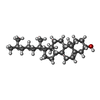
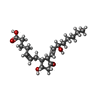

| #6: Chemical | | #7: Chemical | ChemComp-PG2 / | |
|---|
-Details
| Has ligand of interest | Y |
|---|---|
| Has protein modification | N |
-Experimental details
-Experiment
| Experiment | Method: ELECTRON MICROSCOPY |
|---|---|
| EM experiment | Aggregation state: PARTICLE / 3D reconstruction method: single particle reconstruction |
- Sample preparation
Sample preparation
| Component | Name: DP1-PGD2-G protein complex / Type: COMPLEX / Entity ID: #1-#5 / Source: RECOMBINANT |
|---|---|
| Molecular weight | Value: 0.16 MDa / Experimental value: YES |
| Source (natural) | Organism:  Homo sapiens (human) Homo sapiens (human) |
| Source (recombinant) | Organism:  Trichoplusia ni (cabbage looper) Trichoplusia ni (cabbage looper) |
| Buffer solution | pH: 7.4 |
| Specimen | Embedding applied: NO / Shadowing applied: NO / Staining applied: NO / Vitrification applied: YES |
| Vitrification | Cryogen name: ETHANE |
- Electron microscopy imaging
Electron microscopy imaging
| Experimental equipment |  Model: Titan Krios / Image courtesy: FEI Company |
|---|---|
| Microscopy | Model: TFS KRIOS |
| Electron gun | Electron source:  FIELD EMISSION GUN / Accelerating voltage: 300 kV / Illumination mode: FLOOD BEAM FIELD EMISSION GUN / Accelerating voltage: 300 kV / Illumination mode: FLOOD BEAM |
| Electron lens | Mode: BRIGHT FIELD / Nominal defocus max: 5000 nm / Nominal defocus min: 1200 nm |
| Image recording | Electron dose: 50 e/Å2 / Film or detector model: GATAN K3 (6k x 4k) |
- Processing
Processing
| CTF correction | Type: NONE |
|---|---|
| 3D reconstruction | Resolution: 2.72 Å / Resolution method: FSC 0.143 CUT-OFF / Num. of particles: 140051 / Symmetry type: POINT |
 Movie
Movie Controller
Controller




 PDBj
PDBj

